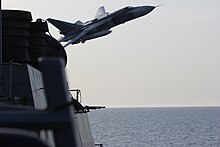Hull Number: DDG-75
Launch Date: 05/03/1997
Commissioned Date: 08/21/1998
Call Sign: NDGC
Voice Call Sign: FEARLESS WARRIOR
Class: ARLEIGH BURKE
ARLEIGH BURKE Class
Namesake: DONALD GILBERT COOK
DONALD GILBERT COOK
Wikipedia (as of 2024)
Donald Gilbert Cook (August 9, 1934 – December 8, 1967) was a United States Marine Corps officer and a Medal of Honor recipient.
Donald Cook was born in Brooklyn, New York. He attended Xavier High School in New York City and St. Michael’s College in Vermont. In 1956 he enlisted in the Marine Corps as a private but was quickly sent for officer training at the Officer Candidates School in Quantico, Virginia. He was commissioned a second lieutenant in 1957. In 1960 he attended Army Language School in Monterey, California, studying Chinese and graduated near the top of his class. Lieutenant Cook was assigned to Camp H.M. Smith, Hawaii, in 1961 and was promoted to captain on March 1, 1962. He held a series of assignments in the Marine Corps and was sent to South Vietnam in late 1964, where he served as an advisor to the Vietnamese Marine Division until he was wounded and captured by the Viet Cong several weeks later. He was held as a prisoner of war by the Viet Cong from December 31, 1964, until his death from malaria at age 33 on December 8, 1967, and was buried in the jungle by his fellow prisoners. He was posthumously promoted from captain to colonel. On February 26, 1980, he was officially declared dead and the Medal of Honor was presented to his wife by the Secretary of the Navy.
Cook’s body was never recovered. An official memorial stone (cenotaph) can be found in Arlington National Cemetery, Arlington, Virginia, Memorial Section MI Lot 110.[1]
Citation for award of Medal of Honor:
For conspicuous gallantry and intrepidity at the risk of his life above and beyond the call of duty while interned as a Prisoner of War by the Viet Cong in the Republic of Vietnam during the period 31 December 1964 to 8 December 1967. Despite the fact that by so doing he would bring about harsher treatment for himself, Colonel (then Captain) Cook established himself as the senior prisoner, even though in actuality he was not. Repeatedly assuming more than his share of responsibility for their health, Colonel Cook willingly and unselfishly put the interests of his comrades before that of his own well-being and, eventually, his life. Giving more needy men his medicine and drug allowance while constantly nursing them, he risked infection from contagious diseases while in a rapidly deteriorating state of health. This unselfish and exemplary conduct, coupled with his refusal to stray even the slightest from the Code of Conduct, earned him the deepest respect from not only his fellow prisoners, but his captors as well. Rather than negotiate for his own release or better treatment, he steadfastly frustrated attempts by the Viet Cong to break his indomitable spirit and passed this same resolve on to the men whose well-being he so closely associated himself. Knowing his refusals would prevent his release prior to the end of the war, and also knowing his chances for prolonged survival would be small in the event of continued refusal, he chose nevertheless to adhere to a Code of Conduct far above that which could be expected. His personal valor and exceptional spirit of loyalty in the face of almost certain death reflected the highest credit upon Colonel Cook, the Marine Corps, and the United States Naval Service.

